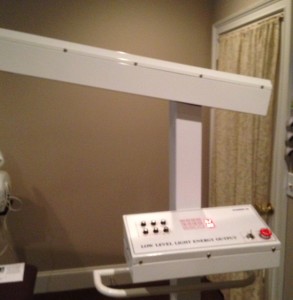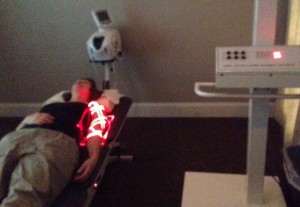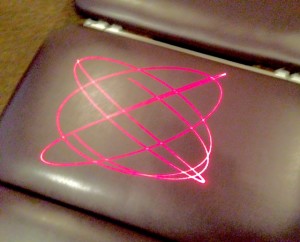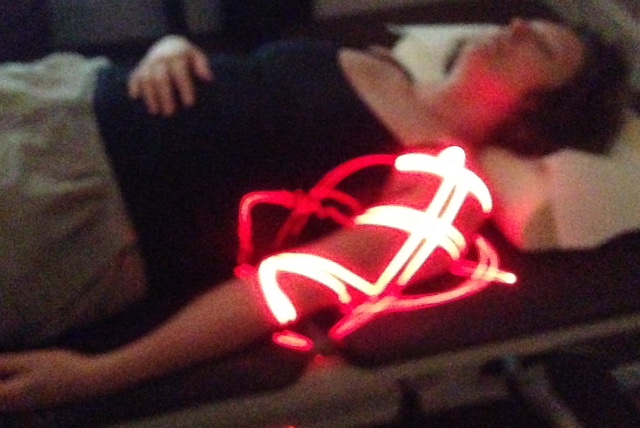Imagine a treatment for pain that is easy, fast, simple, inexpensive, and has zero risks and zero side effects.
Sound like science fiction?
It already exists, and was approved 15 years ago by the FDA: low-level laser therapy.
I’ve had two treatments, and those few minutes of laser did more to relieve my frozen shoulder pain than eight long sessions of physical therapy have done.
It was quick and simple and clean.
Seems to me there ought to be a cold laser machine on every street corner. But you won’t find this therapy offered in MD’s offices.
The machine itself is at least $20,000, and insurance won’t cover cold laser treatments. That’s because it’s considered “experimental.”

Tell that to Sean McWilliams, the chiropractor at Alpharetta Spinal Correction Center, who’s been using it for 15 years. He’s found it effective on frozen shoulder, tendonitis, carpal tunnel syndrome, tennis elbow, plantar fascitis, arthritis, and other painful joint conditions that otherwise would be treated with lots of expensive drugs and surgery.
It’s not like McWilliams is getting rich off this machine. He only charges $20 and for years charged only $15. He could certainly charge more – but he feels it’s important to keep this therapy in affordable reach of as many people as possible.

My guess is that one day, this will be as widely accepted and used as acupuncture. I paid cash for all my acupuncture treatments in 1993-94 … because it was considered “experimental” then. Now it’s accepted by all major insurance companies.
I found McWilliams from a Google search after I got excited about laser therapy from reading about it in “The Brain’s Way of Healing” by neuroscientist Norman Doidge. He explains the science of it (and other non-mainstream treatments) very well.
First the overview:
…our bodies are filled with numerous light-sensitive chemical switches and amplifiers. Different colors or wavelengths of light have different effects. Some colors stimulate bodily enzymes to work more effectively and can turn processes in our cells on and off and affect which chemicals they produce.

Doidge explains that the sun’s energy affects the body because the photons can pass through cell membranes and stimulate the creation of ATP (adenosine triphosphate), a molecule that stores energy to power the work of the cell. The cold laser works much the same way, but in a targeted fashion:
Laser light triggers ATP production, which is why it can initiate and accelerate the repair and growth of healthy new cells, including those that make up cartilage (chondrocytes), bone (osteocytes), and connective tissue (fibroblasts).
There have been dozens of double-blind studies demonstrating the effectiveness of cold lasers. There have also been studies that showed no effect.
Those who study low-level laser therapy say that the problem with the negative studies is that (unlike pharmaceuticals) there’s no one-size-fits-all approach to using cold lasers.
The negative studies, a group of doctors wrote in a medical journal article, “should not be taken to imply that LLLT in general does not work but rather that the laser parameters used in those particular studies were ineffective.”
You can try this at home, but be careful buying an amateur-level machine. All devices are not alike, and some of them are just not useful.
More large-scale research is needed.
If they need guinea pigs, I’m so there.
Here’s a Q&A and a history of cold laser therapy if you want to know more.
Today’s penny is a 2002, the year that the FDA approved the cold laser for therapy.

How wonderful for you to finally get some relief. and that is one cool photo.
Thanks. Up next: Laser on neuropathy!!
That’s so cool! Is there laser for neuropathy. My Mom’s feet and legs kill her.
Yes! at least two places offer it in Atlanta:
http://www.atlantamedicalclinic.com/neuropathy/
http://www.atlantaneuropathy.com/
Here’s a piece about the pros and cons:
http://www.livestrong.com/article/549625-success-drawbacks-of-laser-therapy-for-neuropathy-surgery/